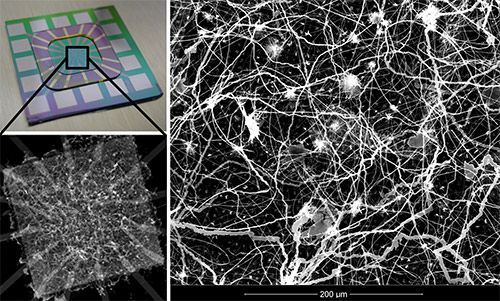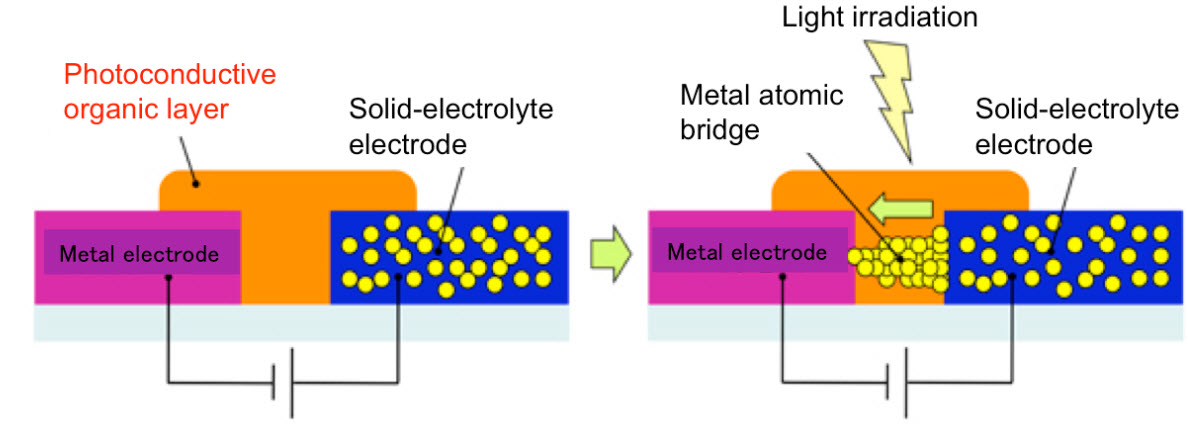Neuromorphic ‘atomic-switch’ networks function like synapses in the brain
August 19, 2014

A look inside the atomic-switch network device reveals its highly interconnected architecture, which comprises synaptic “atomic switch” circuit elements at each point of contact between silver nanowires. The collective interactions between these atomic switches result in unique, emergent properties that have shown significant potential for neuromorphic computing. (Credit: MANA)
Researchers in the U.S. and Japan have developed a self-assembled neuromorphic (brain-like) device comprising more than a billion interconnected “atomic-switch” inorganic synapses embedded in a complex network of silver nanowires.
The researchers are located at the California NanoSystems Institute (CNSI) at the University of California, Los Angeles (UCLA) and the International Center for Materials Nanoarchitectonics (MANA) at the National Institute for Materials Science, Japan.
The atomic switch, a recently developed nanoscale circuit element, has been shown to possess synapse-like properties in a purely inorganic device. The device uses a billion junctions per square centimeter incorporated into a densely interconnected network of silver nanowires.
What is an “atomic switch”?

Operating mechanism of a light-controlled atomic switch. (Left) Photocurrent induced in the photoconductive organic layer by light-irradiation reduce metal cations (ions with a positive charge) in the solid-electrolyte (a substance that ionizes) electrode, which precipitate as metal atoms to form a metal atomic bridge between the metal electrode and the solid-electrolyte electrode. (Right) Operating result of light-controlled atomic switch. Light-irradiation with an applied bias (voltage) is needed to turn the switch on. Inserted images show a metal atomic bridge formed in the turning-on process. (The photoconductive organic layer was removed to see the metal atomic bridge.) — MANA (adapted)
Like biological neural networks, these atomic switch networks (ASN) generate memristor-like emergent behaviors comprised of their distributed, collective interactions.
These emergent behaviors are a principal characteristic of biological neural networks and many other complex systems. Ongoing studies involve the use of these emergent behaviors for information processing, aimed toward developing a new class of cognitive technologies, according to the researchers.
The ASN device has a highly interconnected architecture that comprises synaptic circuit elements at each point of contact between nanowires. The collective interactions between these atomic switches result in unique emergent properties that have shown significant potential for neuromorphic computing, the researchers say.
The study was published in PLOS ONE and the Japanese Journal of Applied Physics, both open-access. This research was partially supported by the Defense Advanced Research Projects Agency (DARPA) “Physical Intelligence” program and by the WPI International Center for Materials Nanoarchitectonics (MANA).
Abstract of PLOS ONE paper
Efforts to emulate the formidable information processing capabilities of the brain through neuromorphic engineering have been bolstered by recent progress in the fabrication of nonlinear, nanoscale circuit elements that exhibit synapse-like operational characteristics. However, conventional fabrication techniques are unable to efficiently generate structures with the highly complex interconnectivity found in biological neuronal networks. Here we demonstrate the physical realization of a self-assembled neuromorphic device which implements basic concepts of systems neuroscience through a hardware-based platform comprised of over a billion interconnected atomic-switch inorganic synapses embedded in a complex network of silver nanowires. Observations of network activation and passive harmonic generation demonstrate a collective response to input stimulus in agreement with recent theoretical predictions. Further, emergent behaviors unique to the complex network of atomic switches and akin to brain function are observed, namely spatially distributed memory, recurrent dynamics and the activation of feedforward subnetworks. These devices display the functional characteristics required for implementing unconventional, biologically and neurally inspired computational methodologies in a synthetic experimental system.
Abstract of Japanese Journal of Applied Physics paper
The spontaneous emergence of complex behavior in dynamical systems occurs through the collective interaction of nonlinear elements toward a highly correlated, non-equilibrium critical state. Criticality has been proposed as a model for understanding complexity in systems whose behavior can be approximated as a state lying somewhere between order and chaos. Here we present unique, purpose-built devices, known as atomic switch networks (ASN), specifically designed to generate the class of emergent properties which underlie critical dynamics in complex systems. The network is an open, dissipative system comprised of highly interconnected (~109/cm2) atomic switch interfaces wired through the spontaneous electroless deposition of metallic silver fractal architectures. The functional topology of ASN architectures self-organizes to produce persistent critical dynamics without fine-tuning, indicating a capacity for memory and learning via persistent critical states toward potential utility in real-time, neuromorphic computation.